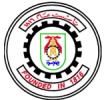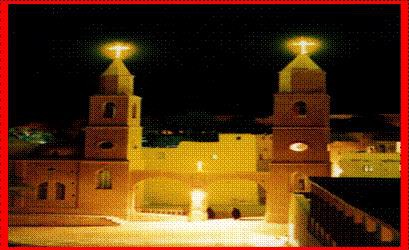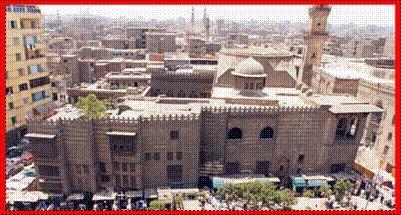Engineering Center for Archaeology and
Environment
(E.C.A.E.)
Director:
Prof. Dr. Mohamed Reda Abdallah
Introduction
The Very successful Co-operation between the Mining Department at the Faculty of Engineering, Cairo University and the Nancy School of Mines, France, was the nucleus of the present activities of the Center.
This Co-operation aimed to apply geotechnical science to the preservation of historical monuments and has concretized by the Establishment of the ECAE.
The Engineering Center for Archaeology and Environment was established on August 28th, 1992 after several years of experience in the conservation of historical sites and monuments within Cairo University.
Main Objectives
Applying recent engineering sciences and technologies in the field of conservation and restoration of historical sites and monuments.
Missions
The Center’s mission has essentially developed around three axes of work :
• Research : adaptation and development of research in conservation methodology.
• Consultation and technical Support for the Supreme Council of Antiquities (SCA) or for foreign archaeological teams.
• Continuing Education and Training of Specialists in the fields of Engineering & Archaeology and Environment.
Missions
The ECAE’s mission ‘essentially’ has been developed around three axes of work:
1. Undertaking research works: adaptation and development of research in restoration methodology.
2. Providing consulting and technical assistance operations for the Supreme Council of Antiquities (SCA) and foreign Antiquities departments and missions.
3. Providing continuing education and training of specialists in engineering, archaeological and environmental fields.
Competence
The ECAE hosts several specialized teams in various fields such as:
Surveying & Photogrammetry, Architectural Documentation, Urban Design Works, Structural & Earthquake Engineering, Geotechnical Engineering, Mining Engineering, Geology, Material Sciences & Deterioration phenomena and preparation of complete restoration projects (bill of quantities, follow-up the execution of works), as well as Monitoring of old buildings and historical sites.
Means
The ECAE uses advanced technology and equipment in executing its projects, e.g. PC computers, scanners, digitizers, plotters, total stations, stereo plotter, photocopiers, x-ray, soil & rock testing instruments, geophysical surveying instruments, cameras, endoscopes, optical polarized light microscope, scanning electron microscope, special machines to
perform different tests on stones and numerical modeling software.
Associated Iaboratories
ln addition to its own facilities, the ECAE is associated with 5 laboratories of Cairo University. Their competence is usually used in implementing the required projects and activities. The 5 laboratories are:
• Rock Mechanics laboratory, Faculty of Engineering.
• Geotechnical Engineering laboratory, Faculty of Engineering.
• Data Processing laboratory, Faculty of Engineering.
• Atmosphere Measures and Aerodynamic laboratory, Faculty of Engineering.
• Fine Restoration laboratory, Faculty of Archaeology.
• Two protocols have been signed on the 10th of October 1992; the first is between the Cultural Service for Scientific and Technical Co-operation of the Embassy of France in Egypt and the ECAE for the exchange of experts and the training of young engineers. Since 1993, within this co-operation, many engineers have earned scholarships for training and Ph.D. for Egyptians in France and also, for French students in Egypt.
• The second is for the collaboration, in the field of environment protection between the National Institute for Industrial Environment and Risks (INERIS) and the ECAE. The Strata Control laboratory of the Nancy School of Mines (NCM), associated with INERIS shares the responsibility of training the engineers of the ECAE in France.
• Later a protocol has been signed between the High School for Arts and Industries of Strasbourg (ENSAIS) and the ECAE for a collaboration in the fields of surveying and Photogrametry. The agreement enhances co-operation in joint projects and forecasts the training of engineers on surveying and photogrametry.
• Participation in a workshop organized by Department of Culture Heritage, UNESCO Paris about “Universities and Culture Heritage “held in Valencia, Spain October l996.
• Participation in a workshop organized by Autonoma University -Barcelona, Spain and National Institute of Culture Heritage- Tunis, under the auspice of European Union about ” Application of New Technology in the Field of Culture Heritage “held in Tunisia, June 1997.
• Organization of 3 workshops in collaboration with UNESCO Cairo Office, NCM, INERIS.
French Ministry of Foreign Affairs about ” Application of New Technology in the field of Culture Heritage”:
1. Under the auspice of Arab League, held in Cairo, Egypt, December 1994.
2. Under the auspice of her Excellency Dr. Nagah El-Attar, Syrian Minister of Culture, in collaboration with General Department of Antiquities & Museums, Damascus, Syria, December 1996.
3. Under the auspice of his Excellency Mr. Fawzi Houbeish, Lebanese Minister of Culture and Higher Education, in collaboration with Faculty of Architecture, Arab University, Beirut, Lebanon, April 1998.
Partners
At present time, the ECAE has a strong scientific collaboration protocols with many national and international institutions of excellent reputation such as:
– The protocol signed in 1992 with the Co-operation & Cultural Services Center, French Embassy in Cairo, for the exchange of experts and training of young engineers in both countries (Egypt and France). Several scholarships and training stages are conferred to the ECAE ‘ s staff and personnel.
– The protocol signed with the Ecole des Mines de Nancy, France with Laboratoire Environement Géomécanique & Ouvrages (LEGO), for the exchange of experts and training of engineers in both countries (Egypt and France).
– The protocol signed with the National lnstitute for Industrial Environment And Risks (INERIS), France for the exchange of experts and training of engineers in the fields of environmental studies.
– The protocol signed with the Ecole d’ Arts et des Meties de Strasbourg (ENSAIS), France, for the exchange of experts and training of engineers in the surveying field and photogrametry studies.
– The Syrian Authority of Antiquities, Syria. Several scholarships and training stages are conferred to Syrian engineers both in Egypt and in Syria.
Achievements
ECAE prepares work plans, which include architectural documentation of buildings, topographic survey of sites, study of the structural stability of monuments, and study of degradation of building materials; such studies lead to complete restoration projects. Also ECAE provides technical support and consultation responding to determined problems of conservation in given historical sites and buildings. The following are examples of restoration projects implemented by the ECAE.
A. Islamic and Coptic Monuments
– Studies made for the Supreme Council of Antiquities (SCA}:
Documentation and restoration projects of the following monuments and sites:
I. EI-Sweedy Mosque in Old Cairo.
2. The Khanqah of Shaikhu in the Citadel area.
3. The Northern Wall of Islamic Cairo.
4. St. Antony Monastery, Red Sea.
5. Mohamed Ali’s Palace at Shoubra.
6. Hanging Church and The Coptic Museum in Old Cairo.
7. Saray El-Mosafr Khana, Gamalia, Cairo.
8. Sour Magra Al Oyoun (Cairo Aqueduct), Cairo.
9. AMR Ibn El-AS Mosque, Old Cairo.
10. El Salam Canal Salvage Project, Sinai.
– Studies made for the Historic Cairo Project :
Documentation and restoration projects of the following monuments and sites:
1. Stage I – Group III (El-Ghoury Group).
2. Stage I – Group IV (Rebuild Saray El-Mosafr Khana, Gamalia, Cairo).
3. Stage III – Group I.
4. Prince Taz Palace – El-Siyufiyah St.
B. Pharaonic Monuments
– Planning :
Conservation project of Pyramids’ Plateau under the supervision of UNESCO Survey and Topography: Heibis Temple (SCA) and Dendra Temple in Qena (IFAO).
– Stability Analysis for underground structures:
Serapeum, Baboons Tomb, Birds Tomb, Skhem Khet Tomb and Apperia Tomb in Saqqarah.
– Structural Stability Analysis:
Memnon Colossi, Hachepsut Temple (Deir el Bahari), and first pylon of the Temple of Ramses-II (Ramesseum) in Luxor with the CNRS mission for the Ramesseum; directed by C.Leblanc.
– Study of Pharonic Mines:
Copper Mines of the Wadi Dara with a team of the French Institute for Oriental Archaeology (IFAO)
– Conservation of Historical Sites:
Project of Protection and Development of the Pyramids’ Plateau in Giza.
– Study of Stone Degradation:
The Sphinx, Egypt
C. International Projects
– Pilot project of the documentation and restoration of the Citadel of Damascus, Syria.
– Zaghwan Aqueduct, Tunisia (undergoing)
– Study of Stone Degradation: Hamoud Palace and El-Emary Mosque, Sayda, Lebanon.
For Further Information, Please Contact:
Tel.: (202) 35723270 Fax. (202) 35723270



